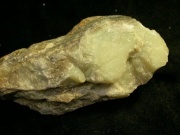Pyrophyllite
Jump to navigation
Jump to search
Description
A soft, fibrous or flaky, mineral of basic aluminum silicate. Pyrophyllite occurs as fine-grain masses in the Ural mountains, Switzerland (Zermatt), South Africa, Canada and the U.S. (North Carolina, Georgia, California). The pearly white, yellow or green mineral can be difficult to distinguish visually from talc. Pyrophyllite was carved by the ancient Chinese into small figurines and ornaments. It was used in slate pencils and tailor's chalk and is still used as a filler in ceramics, paints and plastics.
Synonyms and Related Terms
African wonderstone; phillite; tailor's chalk; slate pencil; pirofilita (Esp.); pirofilite (Port.); Pyrophyllit (Deut.) ; pyrofylliet (Ned.)
Physical and Chemical Properties
- Monoclinic system, crystals are rare, usually fine-grain masses
- Perfect cleavage in one direction
- Fracture = uneven or splintery
- Luster = pearly to dull
- Streak is white.
- Composition = Al2Ai4O10(OH)2
- Mohs Hardness = 1.0 - 2.0
- Density = 2.6 - 2.9 g/ml
- Refractive Index = 1.53; 1.58; 1.60
Resources and Citations
- Mineralogy Database: Pyrophyllite
- G.S.Brady, Materials Handbook, McGraw-Hill Book Co., New York, 1971 Comment: p. 643
- Michael McCann, Artist Beware, Watson-Guptill Publications, New York City, 1979
- Encyclopedia Britannica, http://www.britannica.com Comment: pyrophyllite" [Accessed December 4, 2001]. (tech info)
- C.W.Chesterman, K.E.Lowe, Audubon Society Field Guide to North American Rocks and Minerals, Alfred A. Knopf, New York, 1979
- Wikipedia: http://en.wikipedia.org/wiki/Pyrophyllite (Accessed Sept. 14, 2005)
